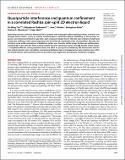Files in this item
Quasi-particle interference and quantum confinement in a correlated Rashba spin-split 2D electron liquid
Item metadata
| dc.contributor.author | Yim, Chi Ming | |
| dc.contributor.author | Chakraborti, Dibyashree | |
| dc.contributor.author | Rhodes, Luke Charles | |
| dc.contributor.author | Khim, Seunghyun | |
| dc.contributor.author | Mackenzie, Andrew | |
| dc.contributor.author | Wahl, Peter | |
| dc.date.accessioned | 2021-04-12T08:30:08Z | |
| dc.date.available | 2021-04-12T08:30:08Z | |
| dc.date.issued | 2021-04-09 | |
| dc.identifier | 270945316 | |
| dc.identifier | c741c885-1f25-48cb-8a27-08c7c71f3e5e | |
| dc.identifier | 85104167734 | |
| dc.identifier | 000642446300005 | |
| dc.identifier.citation | Yim , C M , Chakraborti , D , Rhodes , L C , Khim , S , Mackenzie , A & Wahl , P 2021 , ' Quasi-particle interference and quantum confinement in a correlated Rashba spin-split 2D electron liquid ' , Science Advances , vol. 7 , no. 15 , eabd7361 . https://doi.org/10.1126/sciadv.abd7361 | en |
| dc.identifier.issn | 2375-2548 | |
| dc.identifier.other | ORCID: /0000-0002-8635-1519/work/92020003 | |
| dc.identifier.other | ORCID: /0000-0003-2468-4059/work/92020205 | |
| dc.identifier.uri | https://hdl.handle.net/10023/23009 | |
| dc.description | Funding: C.M.Y. and P.W. acknowledge support from the Engineering and Physical Sciences Research Council (EP/S005005/1), D.C. from the International Max Planck Research School for the Chemistry and Physics of Quantum Materials, L.C.R. from the Royal Commission for the Exhibition 1851, and A.P.M. from the Max Planck Society for the Advancement of Science. C.M.Y. acknowledges additional support from a Shanghai talent program. | en |
| dc.description.abstract | Exploiting inversion symmetry breaking (ISB) in systems with strong spin-orbit coupling promises control of spin through electric fields—crucial to achieve miniaturization in spintronic devices. Delivering on this promise requires a two-dimensional electron gas with a spin precession length shorter than the spin coherence length and a large spin splitting so that spin manipulation can be achieved over length scales of nanometers. Recently, the transition metal oxide terminations of delafossite oxides were found to exhibit a large Rashba spin splitting dominated by ISB. In this limit, the Fermi surface exhibits the same spin texture as for weak ISB, but the orbital texture is completely different, raising questions about the effect on quasiparticle scattering. We demonstrate that the spin-orbital selection rules relevant for conventional Rashba system are obeyed as true spin selection rules in this correlated electron liquid and determine its spin coherence length from quasiparticle interference imaging. | |
| dc.format.extent | 8 | |
| dc.format.extent | 583961 | |
| dc.language.iso | eng | |
| dc.relation.ispartof | Science Advances | en |
| dc.subject | QC Physics | en |
| dc.subject | TK Electrical engineering. Electronics Nuclear engineering | en |
| dc.subject | DAS | en |
| dc.subject.lcc | QC | en |
| dc.subject.lcc | TK | en |
| dc.title | Quasi-particle interference and quantum confinement in a correlated Rashba spin-split 2D electron liquid | en |
| dc.type | Journal article | en |
| dc.contributor.sponsor | EPSRC | en |
| dc.contributor.institution | University of St Andrews. Centre for Designer Quantum Materials | en |
| dc.contributor.institution | University of St Andrews. School of Physics and Astronomy | en |
| dc.contributor.institution | University of St Andrews. Condensed Matter Physics | en |
| dc.identifier.doi | https://doi.org/10.1126/sciadv.abd7361 | |
| dc.description.status | Peer reviewed | en |
| dc.identifier.grantnumber | EP/S005005/1 | en |
This item appears in the following Collection(s)
Items in the St Andrews Research Repository are protected by copyright, with all rights reserved, unless otherwise indicated.

